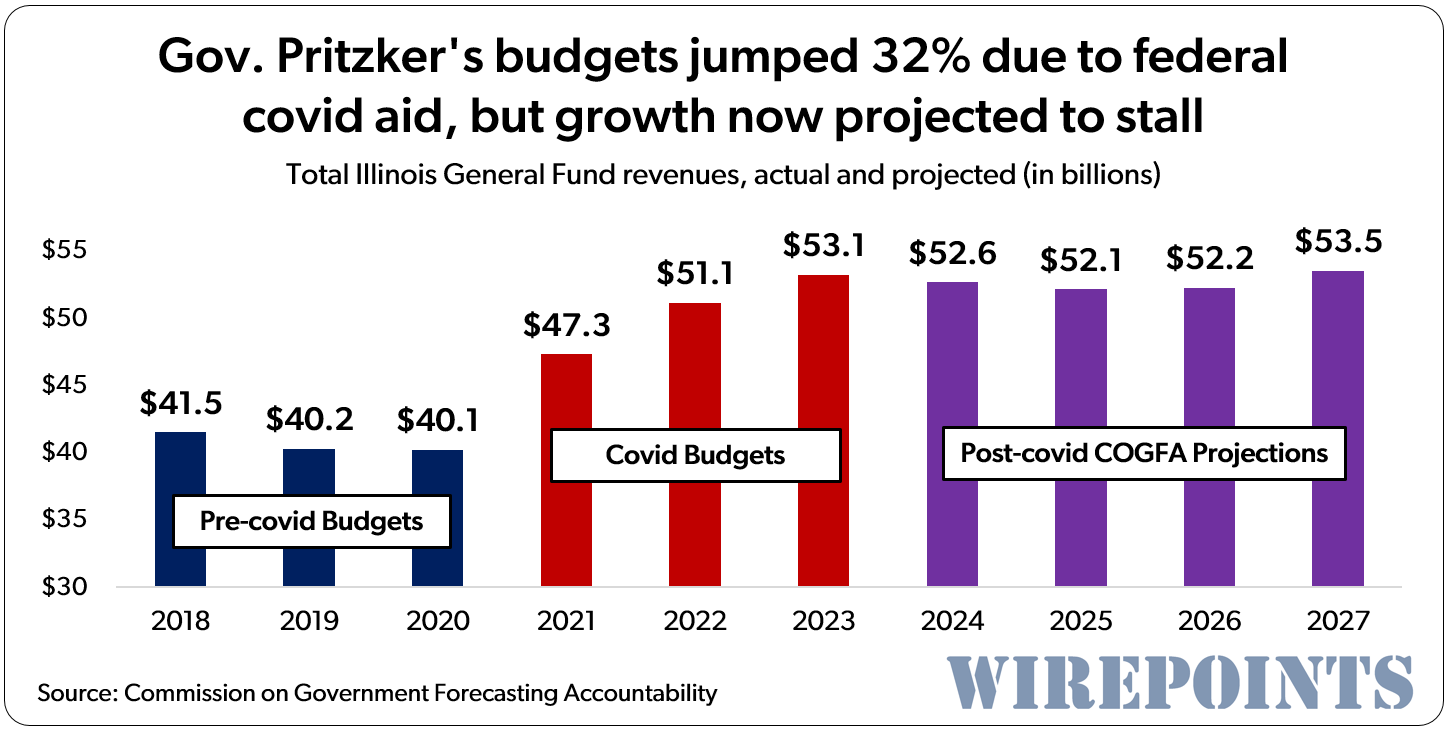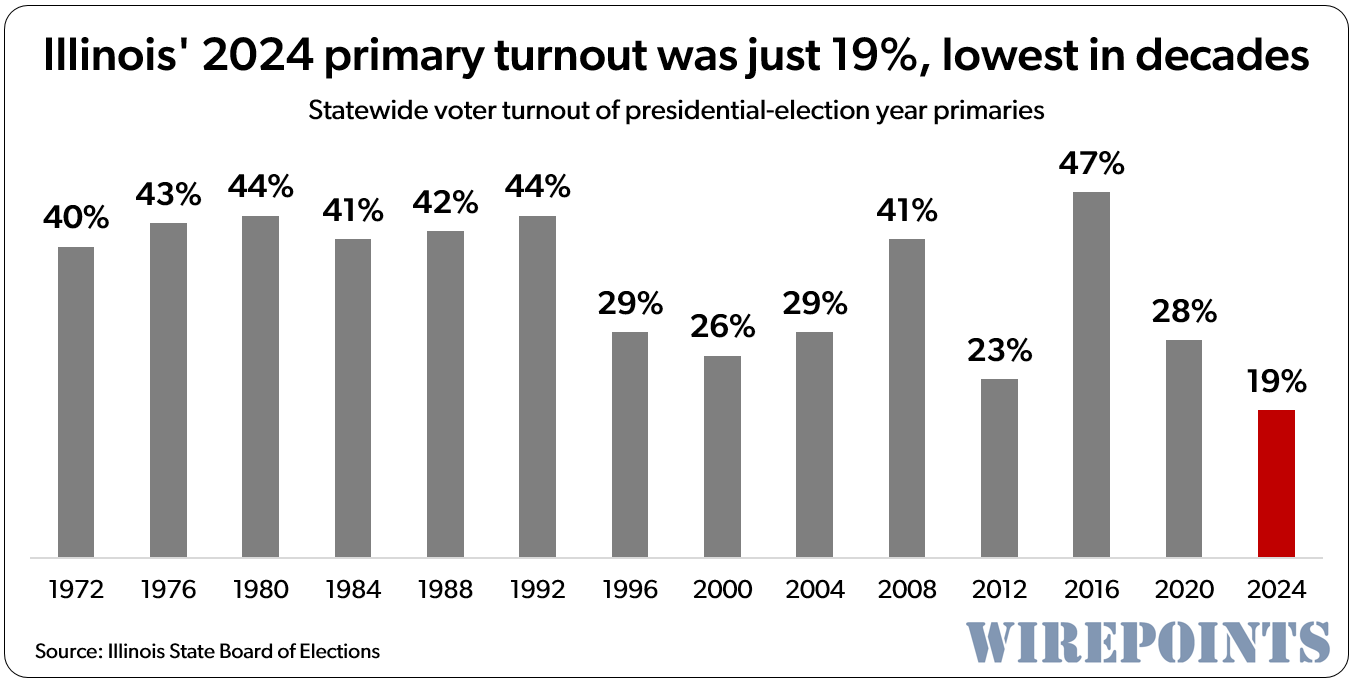By: Mark Glennon*
“Wait a minute,” I said to an Illinois House member at a recent forum, and repeated the question to be sure I had her answer right: “You’re a leading sponsor of a massive rewrite of our energy policy that may cost billions of dollars, but you’re telling me you have no idea how much it costs?
“Yes,” she answered.
She is not alone and that was no isolated incident about one bill. Cost to consumers for sustainable energy is rarely measured and made available to voters, in contrast to other states. Nobody in Illinois seems to care. That comment was from from Robyn Gabel (D- Evanston) and her specific answer was about the Clean Jobs Act now pending in the legislature, but the same indifference to cost has applied to program after program for years in Illinois’ approach to sustainable energy.
Let’s first be absolutely clear: This is not about the global warming debate or the clean energy industry. On the contrary, if you want to reduce carbon emissions, knowing which methods achieve the most reduction per dollar spent should be a key policy determinant. If you don’t think carbon emissions are a problem, you should know how much money is wasted on it. If you are not sure about it, price should be part of getting the answer right.
Obvious as that should be, cost to consumers is disguised or entirely disregarded. Blank checks are fine, as long as they are green. Illinois legislators often either don’t know or don’t care about cost.
The biggest example yet of blank check energy thinking may be that Clean Jobs Bill (HB 2607, SB 1485) now pending in the Illinois legislature. It would likely be the most ambitious and expensive carbon reduction initiative in the Illinois’ history. Because so much money is at stake, let’s look in detail at it first.
The Clean Jobs Bill would raise the target for renewable energy consumption in Illinois from the current goal of 25% by 2025 to 35% by 2030. It would use what’s claimed to be a market-based approach by creating a framework for emissions coupled with an auction of carbon dioxide emission allowances. It’s backed by a long list of sponsors in both the Illinois House and Senate, as well as the Sierra Club, the Citizens Utility Board, the Environmental Defense Fund and plenty of others. It’s chief sponsor in the Senate is Don Harmon (D-Oak Park).
You’ll find plenty of research from those backers about the jobs the bill would create, as well as claims of reductions in overall bills consumers would pay as a result of the bill in its entirety, all of which may well be accurate.
But here’s the thing: You will not find, broken out, the cost to consumers that results from shifting to sustainable energy sources instead of the cheapest available alternatives. That’s because the 271 page bill includes many other things distinct from that number, including extensive measures to encourage energy conservation. It also includes authorization for utilities to charge more during periods of peak usage, something they have long sought, which allows them to reduce average rates for consumers. Perhaps those other provisions are good for consumers and reduce rates. If so, they stand on their merit alone, but they do not bear on the cost of favoring one energy source over another.
Even if you oppose fossil fuel consumption so strongly that you don’t care about cost, the particular cost of each form of renewable energy should matter because, only with that information can you get the most bang for the buck. But that, too, is nowhere to be found. It’s important because the Clean Jobs Bill isn’t really the market-based solution it’s advertised to be. Within the 35% target for renewable energy are mandated, specific allocations for solar, wind and clean coal. What’s the cost rationale behind those mandated allocations? Don’t expect to find an answer.
Try to find a reasonable cost analysis of any of the myriad sustainable energy laws and programs now in place. A list of those laws and programs is reproduced at the end of this article. You’ll find virtually nothing. I’ve made a point of asking supporters of some of those initiatives about cost. They have no answer. I’ve asked Senator Don Harmon (D-Oak Park), lead sponsor of the Clean Jobs Bill, about it’s cost. No response. I followed up with Rep. Gabel several weeks ago after her promise to “get back to me” about the cost the bill she is sponsoring. Nothing. There is nothing to offer.
The Clean Jobs Bill does contain a provision supposedly capping rate increases for consumers, but it’s extremely high. Rates could rise 35% in just 15 years, solely by reason of the increased cost of using more expensive energy sources (in addition to other reasons for higher rates). That cap is stated in annual terms — no more than a 2.015% increase each year. (SB1485, page 50). Sounds harmless unless you remember the power of compounding. Plus, there’s allowance for another 35% over 15 years for higher prices for clean coal facilities, which are also favored under the bill (page 72).
It’s easy to find other states that, unlike Illinois, are asking, “how much will this cost?” Michigan voters rejected a more modest 25% standard by a referendum vote in 2012 of 63% to 27%, opponents having claimed it would cost Michigan $12 billion. Today, it’s a common question because of a pending attempt by the Obama administration to reduce carbon emissions through a national standard, against which the states would have to average out.
Wisconsin, for example, is considering a proposal to reduce coal plant emissions 34% by 2030. That would cost Wisconsin, which is less than half our size, $3 billion to $13 billion, according to the chair of Wisconsin’s Public Service Commission. Indiana has asked the EPA to withdraw Obama’s proposal, predicting an electricity price increase of more than 60 percent. The Public Utility Commission of Texas estimated compliance costs at over $20 billion and that Texas electricity prices would rise by more than 20 percent by 2020.
Is Illinois also to pay billions, but without voters knowing the cost?
Exelon has an alternative bill pending, commonly called the Low Carbon Portfolio Standard (HB3293 and SB1585). Don’t mistake this article for a backhanded endorsement of that bill. It’s similar in some respects to the Clean Jobs Bill but heavily favors nuclear generation, in which Exelon is heavily invested, which the Clean Jobs Bill disfavors. A pitched battle is underway between supporters of the two bills, but the nuclear debate is a different story. This story is just about price tags that nobody can seem to find, including the Chicago Tribune, which put it this way: “About the only guarantee in these bills is that the cost to customers will go up.”
Supporters of the Clean Jobs Bill have other reasons to like the bill besides carbon reduction. Non-carbon emissions would be reduced, too, which is important. Jobs would result (although jobs would also be lost in disfavored sectors, which supporters disregard). And at least one state senator was very clear about still another reason to like it — union jobs in solar and wind installation. Dave Koehler (D-Peoria) said, “The chance to create tens of thousands of new jobs—and add to the ranks of organized labor—is one that we shouldn’t pass up, and that is why I support this bill.”
Whatever the benefits, indifference to cost permeates other Illinois government renewable energy initiatives as well. Try to find anything on point about the original ‘25% by 2025′ statutory standard that’s now in place. You won’t find much if anything. You won’t get it from Senator Harmon, who also sponsored that. I’ve tried to find that, too. The Illinois Power Agency is charged with providing an annual report about the costs of complying with the ’25 by 25’ standard. Its last report is linked here. Its unintelligible, and makes public pension accounting look transparent. Few if any voters or legislators could decipher it.
And this story is certainly not meant as criticism of the renewable energy business in general. On the contrary, that’s big business now and represents a huge part of the technology community that’s thriving in Illinois. It’s not going away. Illinois should strive for leadership in it, but leadership will not be attained by blind spending. Plenty of us are in the camp with an open mind about much of the science on global warming. Many of us prefer to let the market figure out the cheapest alternatives instead of hundreds of pages of regulation written by legislators who think they can pick the winners and losers, unburdened by price tags. But the market has largely already spoken: Countless investors are prepared to bet hundreds of millions of dollars on clean tech, which Illinois should welcome. That, too, is a different story.
Critics of market solutions in energy say, with plenty of good reason, that energy prices are already hopelessly distorted every which way by all kinds of regulation pulling in different direction. Oil has been subsidized for decades through lives and treasure lost in the Middle East. But that calculation is changing. Energy independence is now realistic, though a balance with fossil fuels would remain needed, hopefully including relatively clean natural gas. Illinois is at the center of that revolution. CNBC not long ago ran a rather extraordinary interview showing the unlikely agreement between Rahm Emanuel and Steven Forbes that Chicago can be at the epicenter of the energy revolution. Should Illinois reject that opportunity without even knowing the cost of the alternative?
Don Harmon, a Clean Jobs Bill sponsor, says “Illinois is at a tipping point. There is no time to waste.”
He may actually be right, but tipping towards what? Please, just show us the price tags.
*Mark Glennon is founder of Wirepoints. Opinions expressed are his own.
*****************************
List of Illinois state and local global warming programs:
Green Building Incentive
Industry Recruitment/Support
Local Grant Program
Non-Profit Grant Program
PACE Financing
Performance-Based Incentive
- Illinois Solar Energy Association – Renewable Energy Credit Aggregation Program
- Solar Renewable Energy Credits
Property Tax Incentive
Sales Tax Incentive
State Bond Program
State Grant Program
- Biogas and Biomass to Energy Grant Program
- Community Solar and Wind Grant Program
- Efficient Living Energy Grant
- Energy Efficient Affordable Housing Construction Program
- Public Sector Energy Efficiency Aggregation Program
- Public Sector New Construction and Retrofit Program
- Retro-Commissioning (RCx) Program
- School Energy Efficiency Grant Program
State Loan Program
State Rebate Program
- Energy Impact Illinois Rebates
- Public Sector Electric Efficiency Programs
- Solar and Wind Energy Rebate Program
Utility Loan Program
Utility Rebate Program
- Wabash Valley Power Association (28 Member Cooperatives) – Commercial and Industrial Energy Efficiency Program
- Wabash Valley Power Association (28 Member Cooperatives) – Residential Energy Efficiency Program
- Ameren Illinois (Electric) – Commercial Kitchen and Grocery Incentives Program
- Ameren Illinois (Electric) – Custom, HVAC and Motor Business Efficiency Incentives
- Ameren Illinois (Electric) – Lighting Rebates for Businesses
- Ameren Illinois (Electric) – Multi-Family Properties Energy Efficiency Rebate Program
- Ameren Illinois (Electric) – Residential Energy Efficiency Rebates
- Ameren Illinois (Gas) – Business Efficiency Incentives
- Ameren Illinois (Gas) – Residential Energy Efficiency Rebates
- City Water Light and Power – Commercial Energy Efficiency Rebate Programs
- City Water Light and Power – Residential Energy Efficiency Rebate Programs
- City Water Light and Power – Solar Rewards Program
- ComEd – Business Instant Lighting Discounts Program
- ComEd – Smart Ideas for Business Efficiency Program
- ComEd – Smart Ideas for Business New Construction
- ComEd – Smart Ideas for Your Home Efficiency Program
- ComEd, Nicor Gas, Peoples Gas & North Shore Gas – Complete System Replacement Rebate Program
- ComEd, Nicor Gas, Peoples Gas & North Shore Gas – Small Business Energy Savings Program
- Corn Belt Energy Coop – Commercial Energy Efficiency Rebate Program
- Corn Belt Energy Coop – Residential Energy Efficiency Rebate Program
- Illinois Municipal Electric Agency – Electric Efficiency Program
- Jo-Carroll Energy – Energy Efficiency Rebate Program
- MidAmerican Energy (Electric) – Commercial EnergyAdvantage Rebate Program
- MidAmerican Energy (Electric) – Residential Energy Efficiency Rebate Programs
- MidAmerican Energy (Gas) – Commercial EnergyAdvantage Rebate Program
- MidAmerican Energy (Gas) – Residential Energy Efficiency Rebate Programs
- Nicor Gas – Commercial Energy Efficiency Rebates
- Nicor Gas – Residential Energy Efficiency Rebates
- North Shore Gas – Commercial & Industrial Prescriptive Rebate Program
- North Shore Gas – Residential Rebate Program
- North Shore Gas – Single Family Direct Install
- Peoples Gas & North Shore Gas – Bonus Rebate Program
- Peoples Gas – Commercial & Industrial Prescriptive Rebate Program
- Peoples Gas – Residential Rebate Program
- Peoples Gas – Single Family Direct Install
Rules, Regulations & Policies
Building Energy Code
Energy Efficiency Resource Standard
Energy Standards for Public Buildings
Generation Disclosure
Green Power Purchasing
Interconnection
Net Metering
Public Benefits Fund
Renewables Portfolio Standard
Solar/Wind Access Policy
Solar/Wind Permitting Standards

 Some Illinois lawmakers continue to deny that covid aid and other federal stimulus bailed the state out of its fiscal mess. But a look at past and projected revenues from COGFA shows just how much the bailouts blew out the state’s revenues. And now that they’re over, how much harder it will be for Illinois revenues to grow.
Some Illinois lawmakers continue to deny that covid aid and other federal stimulus bailed the state out of its fiscal mess. But a look at past and projected revenues from COGFA shows just how much the bailouts blew out the state’s revenues. And now that they’re over, how much harder it will be for Illinois revenues to grow. Election integrity – both real and perceived – is essential to government’s legitimacy and stability. Illinois, like the rest of the nation, better fix its problems now.
Election integrity – both real and perceived – is essential to government’s legitimacy and stability. Illinois, like the rest of the nation, better fix its problems now. Ted joined Dan and Amy to talk about Chicago’s latest bond offering, why Chicago’s dismal home value growth is due to poor policies, the next $70 million to be spent on migrants, the 9% salary hikes demanded by the CTU, and why Illinois lawmakers voting to stop Chicago’s selective enrollment schools from being closed is hypocritical.
Ted joined Dan and Amy to talk about Chicago’s latest bond offering, why Chicago’s dismal home value growth is due to poor policies, the next $70 million to be spent on migrants, the 9% salary hikes demanded by the CTU, and why Illinois lawmakers voting to stop Chicago’s selective enrollment schools from being closed is hypocritical. Illinois just suffered the lowest presidential primary turnout since 1960, according to the Illinois State Board of Elections. Blame voter apathy on a lack of competitive elections. On gerrymandering. On the concern people have, thinking their votes don’t matter. It’s likely a little bit of each.
Illinois just suffered the lowest presidential primary turnout since 1960, according to the Illinois State Board of Elections. Blame voter apathy on a lack of competitive elections. On gerrymandering. On the concern people have, thinking their votes don’t matter. It’s likely a little bit of each.
Illinois Power Agency
2015 Annual Report: The Costs and Benefits of Renewable Resource Procurement in Illinois Under the Illinois Power Agency and Illinois Public Utilities Acts
Submitted to the Illinois General Assembly and the Illinois Commerce Commission Pursuant to PA 97-0658
April 1, 2015
http://www.illinois.gov/ipa/Documents/IPA-2015-Cost-Benefits-Renewables-Report-4-1-15.pdf
Mike – That’s just the updated version of the one I linked to. The new one apparently just came out and I will change the link to it. But it’s the same — an unintelligible crock. It does not provide the numbers I am saying we need.
Another lack of leadership in that once again, just like pensions, the State Legislature does not present meaningful long term cost estimates or analysis to taxpayers. The Springfield Legislature didn’t look at long term pension costs for 40 Years when passing benefit hikes to underfunded pensions. Ditto retiree healthcare. Not looking at long term costs is an ingrained culture in Springfield. Managing the flow of campaign contributions and votes seems to be a higher priority. If costs become unmanageable, just pass more legislation, because the Springfield Sausage Factory cannot close. Whatever rules are in place to scrutinize costs seem to… Read more »